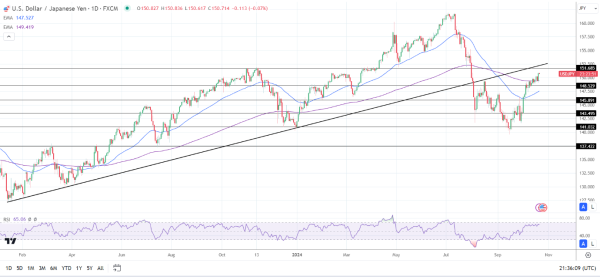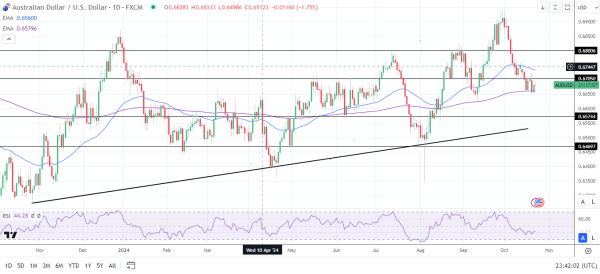Japanese Yen and Australian Dollar News: Japan’s Election and RBA Hawks
Japan’s General Election and the Bank of Japan
Will Japan’s general election disrupt the BoJ’s monetary path? On Sunday, October 27, Japan will hold a general election after new Prime Minister Shigeru Ishiba called for a snap election. The results could influence the Bank of Japan rate path and the USD/JPY pair.
The Prime Minister will try to bolster his leadership of the Liberal Democratic Party (LDP). Prime Minister Ishiba hopes the election will give the LDP a clean slate after political scandals led to the resignation of the former Prime Minister, Fumio Kishida.
However, recent polls suggest an increasing risk that the LDP and its coalition partner, Komeito, may become a minority coalition party. There is also the possibility that the LDP coalition could lose to the opposition, the Constitutional Democratic Party of Japan (CPDJ).
A minority coalition could impact political stability, possibly affecting the BoJ’s ability to raise interest rates. Economists expect a change in government to drive fiscal spending and push to delay BoJ interest rate hikes. The BoJ may wait until the spring wage negotiations before deciding its next monetary policy maneuver.
Notably, the USD/JPY returned to 151, with election polls likely to continue influencing the pair’s trends. The USD/JPY could move toward 152.5 if election polls show an increasing chance of the LDP coalition losing its majority. Conversely, the USD/JPY could fall below 150 if the LDP coalition looks set for a comfortable win.
Traders should monitor the election polls closely, as shifts sentiment could drive volatility in USD/JPY movements.
Japanese Yen Daily Chart
Later in the Wednesday session, the US housing sector will be in focus. Weaker demand for existing homes could signal a deteriorating housing sector, potentially impacting house prices. Falling house prices may affect consumer confidence, possibly curbing consumer spending.
The USD/JPY could drop below 150.5 if existing home sales disappoint on expectations of November and December Fed rate cuts. Conversely, the USD/JPY could target 152 if housing sector data signals a resilient US economy.

RBA Rate Path and AUD/USD Outlook
On Tuesday, October 21, the AUD/USD pair recovered from Monday’s sell-off, eying a return to the $0.67 level.
Investor sentiment toward China’s policy measures continues to support Aussie dollar demand. Effective stimulus measures could improve trade terms between China and Australia, with China accounting for one-third of Aussie exports. Increased demand from China could influence the Aussie economy as it has a trade-to-GDP ratio of over 50%.
Notably, the ongoing rollout of policy measures from Beijing coincides with hawkish RBA commentary. While the BoE, the ECB, the Fed, and other central banks are cutting rates, RBA Deputy Governor poured cold water on investor hopes for a Q4 2024 RBA rate cut. The Deputy Governor cited tight labor market conditions as a stumbling block to cutting interest rates.
Rising bets on the RBA maintaining the cash rate at 4.35% through the remainder of 2024 could push the AUD/USD toward $0.68. Conversely, the AUD/USD could face selling pressure if Beijing holds back from delivering stimulus measures targeting private consumption. Negative sentiment toward the Chinese economy could pull the AUD/USD below $0.66500.
Australian Dollar Daily Chart
Later in the session, US housing sector data could influence sentiment toward the Fed rate path.
A marked decline in existing home sales could signal a weakening housing sector, possibly driving the AUD/USD toward $0.67500. Conversely, an unexpected rise in home sales may support expectations of a resilient US economy and an AUD/USD drop below $0.66500. Economists consider the housing sector a barometer for the US economy.

Keep ahead of the markets with our expert insights. Stay alert to real-time data, central bank views, and expert commentary to adjust your trading strategies accordingly.